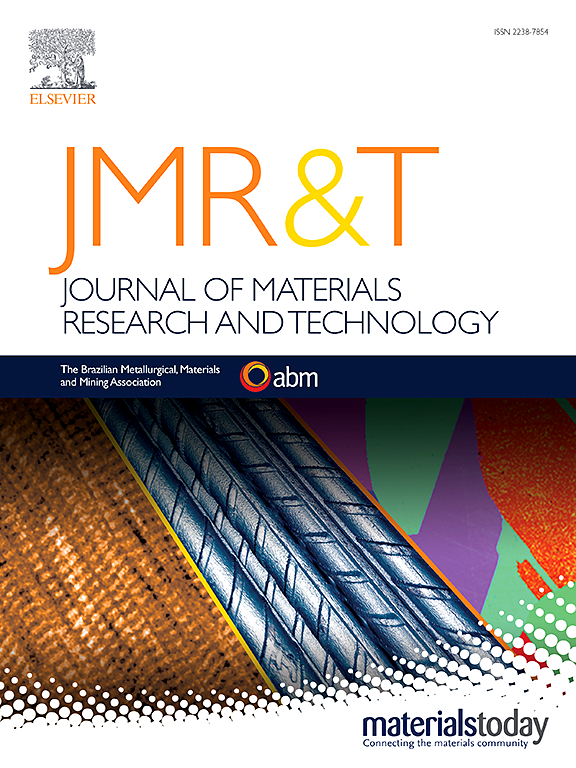Wettability of reaction-bonded SiC surfaces in different concentrations of sulfuric acid: Experimental and simulation study
IF 6.2
2区 材料科学
Q1 MATERIALS SCIENCE, MULTIDISCIPLINARY
Journal of Materials Research and Technology-Jmr&t
Pub Date : 2025-06-04
DOI:10.1016/j.jmrt.2025.05.266
引用次数: 0
Abstract
Silicon carbide (SiC) exhibited high corrosion resistance and was able to maintain a stable solid-liquid interface, which has led to its widespread use in chemical equipment to achieve process intensification and efficiency enhancement. The performance of the equipment is directly influenced by the wettability of the solid-liquid interface. This underscores the necessity of investigating the wettability of SiC materials. In this study, reaction-bonded SiC surfaces with varying topography were fabricated through the adjustment of SiC powder particle size (D50 38.10 μm–2.34 μm) and the application of a reaction sintering process. Systematic examinations were conducted on the wettability of the reaction-bonded SiC surfaces in sulfuric acid solutions at concentrations of 0 wt%, 20 wt%, 50 wt%, and 80 wt% H2SO4. Results demonstrated that the surface morphology of reaction-bonded SiC was altered with decreasing median particle size, leading to a reduction in surface roughness from 9.043 μm to 0.653 μm. This morphological evolution was observed to induce a hydrophobic-to-hydrophilic transition, with maximum 124.371°and minimum 52.505° contact angles being measured in high- and low-surface-tension H2SO4 solutions, respectively. Furthermore, contact angles were observed to increase with the surface tension of H2SO4 solutions on the same surface. At the maximum 50 wt% and minimum 80 wt% surface tension concentrations, the contact angle decreased from 124.371° to 110.557°, which corresponded to an 11.1 % reduction. The conclusions were verified through theoretical calculations and simulations utilizing COMSOL Multiphysics software. This study offers a theoretical foundation for modulating the wettability of reaction-bonded SiC materials suited for use in corrosive liquid-phase environments through surface topography tailoring.
反应键合SiC表面在不同浓度硫酸中的润湿性:实验与模拟研究
碳化硅(SiC)具有较高的耐腐蚀性,并能保持稳定的固液界面,因此在化工设备中得到广泛应用,以实现工艺强化和效率提高。固液界面的润湿性直接影响设备的性能。这强调了研究碳化硅材料润湿性的必要性。本研究通过调整SiC粉末粒径(D50为38.10 μm - 2.34 μm)和采用反应烧结工艺制备了不同形貌的反应键合SiC表面。系统地测试了反应键合SiC表面在硫酸溶液中的润湿性,浓度分别为0 wt%、20 wt%、50 wt%和80 wt% H2SO4。结果表明:随着中位粒径的减小,反应键合SiC的表面形貌发生了变化,表面粗糙度从9.043 μm降低到0.653 μm;观察到这种形态演变诱导了从疏水到亲水的转变,在高表面张力和低表面张力的H2SO4溶液中分别测量到最大124.371°和最小52.505°的接触角。接触角随H2SO4溶液表面张力的增大而增大。在最大50 wt%和最小80 wt%的表面张力浓度下,接触角从124.371°减小到110.557°,减小了11.1%。利用COMSOL Multiphysics软件进行理论计算和仿真,验证了上述结论。该研究为通过表面形貌调整反应键合SiC材料在腐蚀性液相环境中的润湿性提供了理论基础。
本文章由计算机程序翻译,如有差异,请以英文原文为准。
求助全文
约1分钟内获得全文
求助全文
来源期刊

Journal of Materials Research and Technology-Jmr&t
Materials Science-Metals and Alloys
CiteScore
8.80
自引率
9.40%
发文量
1877
审稿时长
35 days
期刊介绍:
The Journal of Materials Research and Technology is a publication of ABM - Brazilian Metallurgical, Materials and Mining Association - and publishes four issues per year also with a free version online (www.jmrt.com.br). The journal provides an international medium for the publication of theoretical and experimental studies related to Metallurgy, Materials and Minerals research and technology. Appropriate submissions to the Journal of Materials Research and Technology should include scientific and/or engineering factors which affect processes and products in the Metallurgy, Materials and Mining areas.
 求助内容:
求助内容: 应助结果提醒方式:
应助结果提醒方式:


